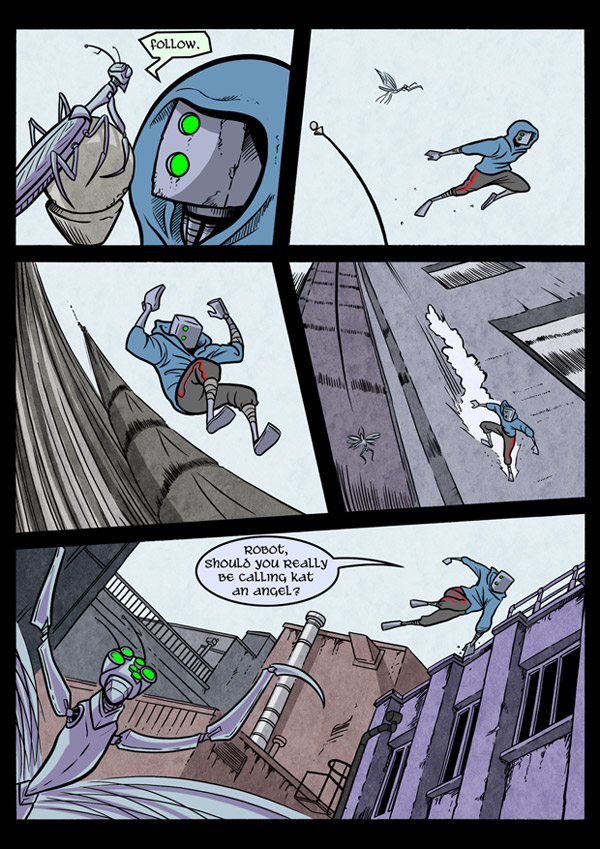From long-running soap operas to comedy-drama slices of life to daily gag strips, the digital comics scene has exploded over the last decade and readers have never had more options. Feeling overwhelmed? Christina Harrington and Joe Stando are here to take you on an expedition through the webcomics wilderness and show you the best specimens in our monthly Deadshirt Webcomics Field Guide.
Gunnerkrigg Court by Tom Siddell
I’ve wanted to write about Gunnerkrigg Court since we first started talking about webcomics on Deadshirt. It’s the perfect embodiment of the potential that webcomics can have, the ways in which a story can grow and develop thanks to the freedom of independent publishing online. Currently at forty-nine chapters and growing, Gunnerkrigg can be intimidating to jump into for new readers, but watching the development of the mythology and the numerous characters throughout those chapters is worth the time needed to catch up. Set at the titular Gunnerkrigg Court, a boarding school with plenty of mysteries of its own, the webcomic follows Antimony (Annie to her friends) Carver as she learns about her parents’ past, her own supernatural powers, and her school’s numerous, and sometimes dangerous, secrets.
The plot for Gunnerkrigg is intricate, with lots of twists as well as satisfying pay-offs for long building narratives, so I won’t be too specific here in summarizing it. The main conflict in the story comes from the ancient tensions between the administration of Gunnerkrigg Court and the mythological inhabitants of a nearby forest. This theme of technology versus nature is at the heart of every conflict in the series, with the tension between the school and the forest grounding itself deeply in the generational storytelling. Both the forest and Gunnerkrigg are vast spaces, both magical in their own ways, both constantly revealing secrets while keeping others hidden. Gunnerkrigg has amnesiac robots; the forest has rude pixies. They’re mirrors of one another and one of the best parts of the comic is learning more about the intertwining history between the two.
The characters themselves are similarly vast in terms of sheer number, as well as in their diversity and abilities. Besides Annie, the other character that could be described as a main character is Katerina “Kat” Donlan. Kat is the daughter of two teachers at Gunnerkrigg, and has a knack for working on and with the numerous robots that populate the school. Kat and Annie are fast friends, but the world of Gunnerkrigg Court is such that their classmates and professors are as fleshed out and as interesting as the two leads. There’s Renard, a fox demon possessing Annie’s stuffed toy; Zimmy, a sarcastic, eyeless girl who sometimes turns into some sort of nightmare creature; Coyote, a literal trickster god and apparent ruler of the forest; Ysengrin, guardian of the forest, a wolf with the body of a tree; plus dozens of others. I really couldn’t list them all here, even though I want to. Badly.
I’m so used to time being a static thing in comics that it’s always a delight to find a comics narrative that allows its characters to age, and Gunnerkrigg is one of those comics. Not only is the reader uncovering the mythology surrounding Annie and Kat’s parents and the generations that came before them at the school, we’re actively involved in watching the mythology around Annie, Kat, and their classmates unfold. Characters date and break up. Traumas have lasting consequences. Abilities and talents develop, and power dynamics in the school and the forest shift and change.
Besides growing and developing these characters in terms of the writing, Gunnerkrigg has also developed in its art merits. In the beginning, Siddell’s line work is simple, the colors more subdued. The level of design has always been there, a mix of fairy tale whimsy and practical tech, but as the story continues the artwork has gotten more intricate and detailed. This is best seen in the development of Coyote. When we first meet him, Coyote is lithe and colorful, literally pushing the boundaries of the Gunnerkrigg reality, as you might expect a trickster god to do. But look at later appearances by the character, and we’re treated to full page splashes of the god as he twists and turns on the page, taking full advantage of the artist’s capabilities. Besides Coyote, every character has a distinct design and look. Even the robots are different from one another, while maintaining an overarching aesthetic that very clearly points to a common origin. In newer chapters, the color work is rich and detailed, sometimes embracing a more watercolor look in order to bring a richness to the world that was otherwise missing.
Gunnerkrigg Court is everything I love about webcomics and is a great example (if not THE example) for why webcomics as a medium is so important. Here we have a story that’s developed over the course of years, and as webcomics readers we get to see that development first hand. Gunnerkrigg Court is so truly epic and so successful in it’s storytelling due, in part, to the fact that it’s being published online. Image and other independent comics publishers have come a long way in creating new spaces for new types of stories to be told, but it’s truly in self publishing and in small presses that we see the most risks being taken. Gunnerkrigg Court is a lesson in watching an artist and creator develop his talents, and push his storytelling limits.
Read Gunnerkrigg Court at Gunnerkrigg.com or click here to start from page one. Don’t forget to check out more Webcomics Field Guides!




